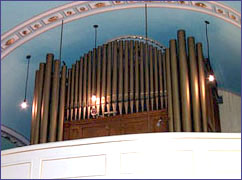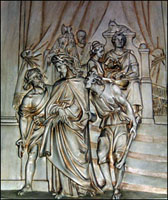
| PLACES |
| Chapel |
| Humboldt Gates |
| Academy Green |
| Arboretum |
| Former Cemetery |
| 1871 Building |
| Convent |
| Interpretive Centre |
| 1910 Addition |
| Auditorium |
| Orchard |
| Novitiate Garden |
| Courtyard |
 |
|
Sylvia Scott, like many of the girls and women at St. Ann’s, had received music training. She attempted to use her piano skills on one occasion, to play the organ. It became a team effort, with Sylvia playing the keys while her friend, down on all fours, played the foot pedals with her hands! The choir loft was weak, so only small numbers went up at any one time. This loft connected to the infirmary, through a small door. Ruth Hall (McIntyre), staying in this room during an illness, felt as if she “lived with the organ”, she was so close to its frequently heard sounds. Music, particularly singing, was an important part of attending the chapel. The sounds would mingle with the visual arts in the room, to inspire thoughts on Christian teachings. Behind the altar were hung, paintings by Sister Mary Helen of the Cross. These were of "Saints Ann and Joachim Teaching Mary” and copies of Murillo's "The Annunciation" and Hoffman's "Jesus Amoung the Doctors in the Temple”. Statues of “Our Lady Queen of the World”, “Saint Thomas Aquinas”, “Saint Anthony of Padua”, “Sacred Heart” and “Saint Joseph”, the foster-father of Jesus and the patron saint of Canada, graced the altar area.
The “Stations
of the Cross”, scenes of Christ’s passion, were symbolic of the
sacrifice made for humanity, one of the fundamental ideas in Christianity.
Usually a series of 14 images, the “Stations of the Cross” in the
chapel were panels that hung along the side walls, allowing room
for visitors to use them during devotions. Catholics would walk
around to each scene, and contemplate its meaning, before moving
on. The boys from St. Louis College would come to the chapel on
certain occasions, and so the devotions of the stations were also
used by the girls as an excuse to talk, secretly, to the boys! The
original series was transferred to another church and replaced by
a series, which was a gift from a Mrs. Wood, between 1929 and 1931.
Stations
of the Cross:
The art glass in the windows enhanced the spiritual feeling in the chapel. In golden amber, reds and greens, the stained glass sheds coloured rays of light on the pews below. This glass work was signed by A.F Roy, maker, 848 Yates St, Victoria 1910. Vandals destroyed much of the glass in the doorway, but the transom, with “S.A.” for “Saint Ann”, the left door, with “I.H.S.”, Christ’s Latin initials, and the right door, with the symbols of a cross, a sword, a crown of thorns and a palm frond, were restored by Mercer and Schaefer Glass Studios. The designs of the windows on the right of the chapel begin with a dove, to represent the Holy Spirit, “Ave Maria”, Latin for Hail Mary, and the “Sacred Heart”, a symbol for Christ, encircled by thorns. The windows on the left depict the Lamb of God, the Latin initials “I.H.S.” and the “Immaculate Heart of Mary”. Click here for more on the Chapel
Contact
St. Anns Academy at stanns.academy@gems2.gov.bc.ca
Contact the Webmaster at zeroone@zeroonedesign.com
|
||||||||



